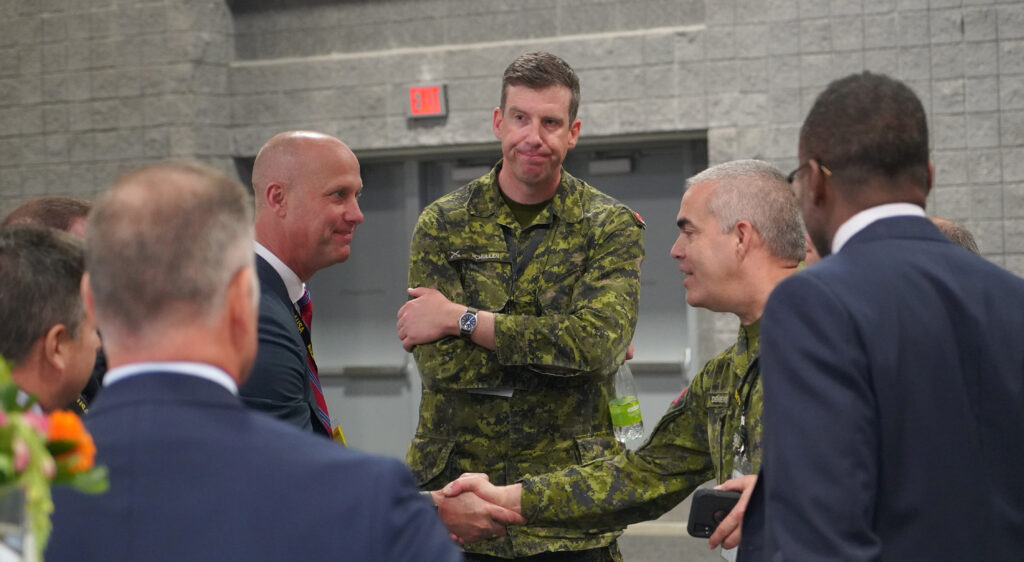“One thing is clear: Digital Transformation is not about transforming our current digital things into better digital things. It is about changing our entire relationship with technology, bringing the CA from an analog organization with legacy industrial-era force structures, tools, processes, governance models and culture, to a true, data-driven, innovative organization that maximally leverages the military potential of digital solutions to influence the battle in our favour — both in the office and in the field.” – Canadian Army, Modernization Vital Ground: Digital Strategy
Technology is rapidly changing in every corner of the world, reinforcing the need to adapt quickly. More advanced sensors and weapon systems, new cyber threats, speed of operations, decentralized command posts, communication, and sharing information with allies, to name a few, require a digital transformation. The ongoing evolution within the Canadian Armed Forces (CAF) is a prime example, where an ever-changing digital battlespace demands a transformation of strategic approaches and operational processes. It is not just a technology upgrade but a new way forward from an organization perspective. Factors contributing to Canada’s evolution in how it trains, and subsequently how it fights, include integrated operational approaches, pan-domain integration, artificial intelligence enhancement, evolved planning and C2, and broad interoperability. Solutions addressing these strategic and operational imperatives exist and are ready to elevate the CAF’s digital campaign.
If the CAF wants to be effective in their operations on the battlefield in today’s world, with today’s threats, they need to adapt quickly. Changes in behaviour beget changes in outcomes.
A digital revolution of the type the CAF is undergoing requires close collaboration with industry to leverage the expertise found within all disciplines – in uniform and out – ensuring that the voices of end-users are heard and their mission requirements are met, swiftly and easily. General Dynamics Mission Systems–Canada is on the ground, working with government stakeholders and end-users to implement this change, and keep the Canadian Armed Forces at the forefront of technological innovation.
Collaborating for Success
General Dynamics is helping with the digital transformation of the CAF, alongside industry partners, with teams working on-site with soldiers on real-world exercises. Their Field Support Team comprises much more than traditional Field Support Representatives (FSRs); it is expertise that comprises Mission Specialists, Software Developers, and System Integrators alongside those FSRs, many of whom are ex-military, with a fulsome understanding of the battlespace and the needs of end-users. This enables a focus on continuous capability sustainment, as well as speed of operational relevance.
Building relationships and rapport with military personnel in real-world exercises is invaluable in the development, delivery, and deployment of capabilities and solutions. Being in proximity to each other throughout testing and integration allows for real-time, on-site help for soldiers. This upholds mission efforts, while also gathering key data points to bring back to integration and testing labs for future development. The relationships built during live exercises are integral to the success of future communications and support beyond initial field testing.
Having an entire Field Support Team on location for development, testing, and field trials, also facilitates architectural and network design changes and can help ensure mission success after deployment by removing the “perfect scenarios” that can occur in a lab. The real-world feedback loop and assistance in establishing the use cases for the system are immeasurable.
Boots on the Ground: A Successful Case Study
General Dynamics works alongside soldiers and contributes to real-world exercises to iterate and develop capabilities for the evolution of the Dispersed Brigade Command Post (CP) Concept. Their Field Support Team worked with troops at CFB Petawawa during Exercises Unified Resolve 23 (Phase II and III), Royal Summons, and Titan Shield (Latvia) to support the Canadian Army Latvia OPERATION REASSURANCE deployment plan.
Members of the Signallers squadron had designed their own network to host a series of Military off-the-shelf (MOTS) and Commercial off-the-shelf (COTS) capabilities to conduct innovative experiments. However, in order to sustain and deploy those resulting capabilities, they would have to exist on the Land Command Support System (LCSS) network. The necessary integration and testing was conducted in support of deploying the capability against a tactical network – in this case, General Dynamics’ network: TNaaS – that would be resilient and sustainable.
The integration work with Signallers and the Brigade groups required the use of various commercial technologies and the ability for them to communicate on a homogenous system and the mission network. The Field Support Team deployed to CFB Petawawa to support making this system work. Being on location meant getting the requirements directly from the soldiers and soldiers getting immediate feedback when seeing changes implemented during the same exercise.
“We see great advantages in working alongside soldiers in situ and being able to integrate their wants and needs almost in real-time to ensure the end product meets their requirements,” says Steve O’Brien, TSIL Lead – LEISC, General Dynamics.
Being embedded at CFB Petawawa allowed the full contingent of experts in the Field Support Team to better understand the pain-points, find solutions, and implement them quickly.
Good For Soldiers
The flexibility and ability of the Field Support Team working directly with the end-user enabled an alignment between the right expertise, resources, and innovation. The creativity, technical proficiency, and transparency about what worked and what didn’t led to successful outcomes and greatly reduced delivery timelines. General Dynamics’ integration approach, paired with end-user engagement, allows the development of unique solutions and capabilities, including integrating products selected by end-users.
Ultimately it’s about delivering what Canadian soldiers need in a timeframe they haven’t seen before. Digital transformation is highly complex and requires highly skilled engineers and technical specialists to enable its evolution. Fortunately, companies such as General Dynamics Mission Systems–Canada have the right expertise to lead the charge. As such, a new era is being championed through a fusion of industry expertise and end-user collaboration, where soldiers’ mission objectives are not just met but exceeded.
